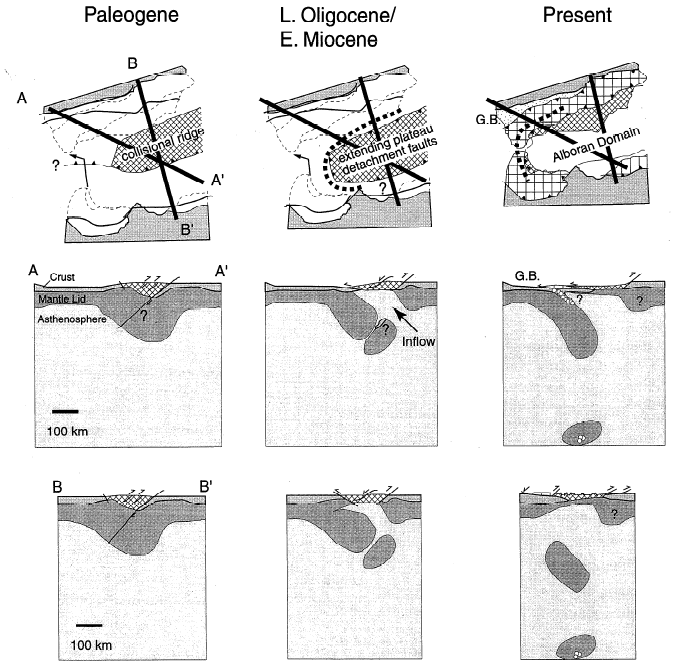Home |
Publications
Calvert, A., Sandvol, E., Seber, D., Barazangi, M., Roecker,
S., Mourabit, T., Vidal, F., Alguacil, G., and Jabour, N.
Geodynamic evolution of the lithosphere and upper mantle beneath the Alboran
region of the western Mediterranean: Constraints from travel time tomography
Journal of Geophysical Research, 105, 10871-10898, 2000.
Abstract
A number of different geodynamic models have
been proposed to explain the extension that occurred during the Miocene in the
Alboran Sea region of the western Mediterranean despite the continued convergence
and shortening of northern Africa and southern Iberia. In an effort to provide
additional geophysical constraints on these models, we performed a local, regional,
and teleseismic tomographic travel time inversion for the lithospheric and upper
mantle velocity structure and earthquake locations beneath the Alboran region
in an area of 800 x 800 km^2. We picked P and S arrival times from
digital and analog seismograms recorded by 96 seismic stations in Morocco and
Spain between 1989 and 1996 and combined them with arrivals carefully selected
from local and global catalogs (1964-1998) to generate a starting data set containing
over 100,000 arrival times. Our results indicate that a N-S line of intermediate
depth earthquakes extending from crustal depths significantly inland from the
southern Iberian coat to depths of over 100 km beneath the center of the Alboran
Sea coincided with a W to E transition from high to low velocities imaged in the
uppermost mantle. A high-velocity body, striking approximately NE-SW, is imaged
to dip southeastwards from lithospheric depths beneath the low-velocity region
to depths of ~350 km. Between 350 and 500 km the imaged velocity anomalies become
more diffuse. However, pronounced high-velocity anomalies are again imaged at
600 km near an isolated cluster of deep earthquakes. In addition to standard tomographic
methods of error assessment, the effects of systematic and random errors were
assessed using block shifting and bootstrap resampling techniques, respectively.
We interpret the upper mantle high-velocity anomalies as regions of colder mantle
that originate from lithospheric depths. These observations, when combined with
results from other studies, suggest that delamination of a continental lithosphere
played an important role in the Neogene and Quaternary evolution of the region.
Click
here to view a PDF of the post-print
Copyright Statement
An edited version of this paper was published
by AGU. Copyright 2000 American Geophysical Union.
Link to
AGU
Key Figures and Captions
Figure 15. Evolutionary model showing map view and two cross
sections modified from working model proposed by Platt and Vissers (1989) (compare
with convective removal model shown in Figure 14, see reference) to explain
results from this tomography study and Platt et al.'s (1998) more recent results.
Thick dashed lines show suggested position for connection of delaminated lithosphere
to surface lithosphere. GB, Guadalquivir Basin. Circles show locations of present
subcrustal seismicity. Not the body shown in the upper mantle in the "Present"
panel of BB' is attached to Iberia to the west of the cross section. Patterns
are the same as those shown in Figures 2 and 14 (see reference). The crooked
arrows shown in the Strait of Gibraltar mark the relative motion of Africa to
Iberia remaining before present.

Home
| Publications

